
Wait, what? These weren’t in chapter one of Genki….
If you’ve studied Japanese, then chances are you’ve seen the voicing marks (tenten in Japanese) that go above some hiragana. You’ve also probably encountered the little circles (maru in Japanese) that go above the hiragana for ha, hi, fu, he, ho, turning them into pa, pi, pu, pe, po.
But something you might’ve never seen before is the little circles being used with other hiragana, namely ka, ki, ku, ke, ko.
▼ Everything I thought I knew about Japanese is a lie….
They may look a little strange to learners of Japanese. How would you even pronounce them? P-ha, p-hi, p-fu?
Nope! These weirdos represent voiced nasal sounds and are pronounced similar to: nga, ngi, ngu, nge, ngo.
▼ Skip to 0:30 in this video to have a nice man in a hat pronounce the difference between the normal ga, gi, gu, ge, go and nga, ngi, ngu, nge, ngo.
Okay, so that’s great and all, but where are these hiragana used? And if they’re so cool, why aren’t students of language ever taught them?
Good questions! These voiced nasal sounds are mostly exclusive to the Eastern dialect of Japan in the Kanto and Tohoku regions (Tokyo, Fukushima, Aomori, etc.). In the Western regions (Hiroshima, Kyushu, etc.), the voiced nasal sounds don’t exist, and they somehow get along just fine with only ga, gi, gu, ge, go.
Since Tokyo Japanese is considered “standard” Japanese, news anchors and announcers have to go through rigorous voice training programs to ensure that they’re giving the “correct” nasal touch to their voiced sounds.
So if you want to sound like a fancy Tokyo-ite, then here’s a handy guide to when your ga, gi, gu, ge, gos should turn into nga, ngi, ngu, nge, ngos:
▼ Red represents the voiced nasal (ng),
and blue represent the normal voiced (g).
▼ The voiced nasal is used for the particle ga, and for every
ga, gi, gu, ge, go sound that doesn’t come at the beginning of a word.
Aside from those undergoing announcer training though, most Japanese people never encounter these bizarre-looking hiragana, and that’s why students of Japanese aren’t taught them.
It makes sense though; in the U.S., we don’t usually take dialect differences into account when spelling English either: “aunt” is spelled the same even in places that pronounce it as “ant,” and “soda” is spelled the same even in places that pronounce it as “pop.”
According to Japanese linguists, the voiced nasal has been slowly dying off, being replaced by the normal voiced sounds that we’re all familiar with. At this rate it might not be too much longer before they’re extinct sounds.
▼ Skip to 1:40 to see how the red circles (normal g) has been invading from the west to take over the green circles (nasal ng) over the past 50 years.
Personally I know that whenever I use the voiced nasals, I just feel like I sound pretentious, so I usually keep them hidden away in my nose. But what do you do when you speak Japanese? Were you taught to use the voiced nasals? If so, let loose with some in the comments, so we can preserve their nasal-y beauty for all eternity.
References: NHK Online, Notre Dame Seishin University
Images: ©RocketNews24
[ Read in Japanese ]

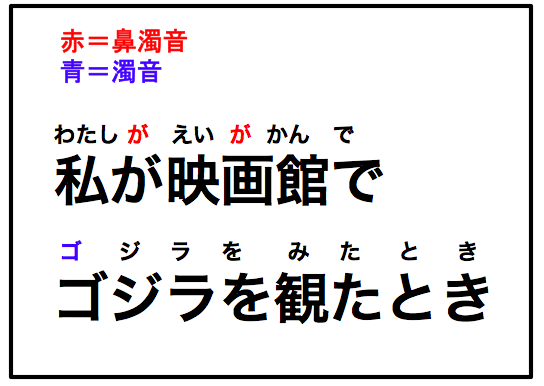
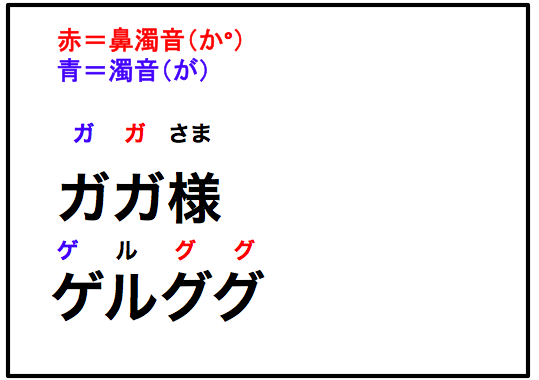
 Learn Japanese through ridiculous manga: A Tick on Titan 【Episode #3】
Learn Japanese through ridiculous manga: A Tick on Titan 【Episode #3】 Learn Japanese through ridiculous manga: Death Vote 【Episode #6】
Learn Japanese through ridiculous manga: Death Vote 【Episode #6】 The surprising reasons why some hiragana aren’t allowed to be used on Japanese license plates
The surprising reasons why some hiragana aren’t allowed to be used on Japanese license plates Learn Japanese through ridiculous manga: Narutoe 【Episode #2】
Learn Japanese through ridiculous manga: Narutoe 【Episode #2】 Seven mistakes foreigners make when speaking Japanese—and how to fix them
Seven mistakes foreigners make when speaking Japanese—and how to fix them Foreign traveler caught trying to sneak into Japan by climbing down rope from cruise ship
Foreign traveler caught trying to sneak into Japan by climbing down rope from cruise ship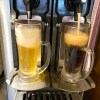 All-you-can-drink deal for US$4 in Shinjuku is one of the best finds in Tokyo
All-you-can-drink deal for US$4 in Shinjuku is one of the best finds in Tokyo McDonald’s Japan’s new pancake pie is a taste sensation
McDonald’s Japan’s new pancake pie is a taste sensation Starbucks at Shibuya Scramble Crossing reopens, but is it really bigger and better than before?
Starbucks at Shibuya Scramble Crossing reopens, but is it really bigger and better than before? One of Japan’s oldest castles now lets travelers spend night on the grounds, drink in its keep
One of Japan’s oldest castles now lets travelers spend night on the grounds, drink in its keep Orange Juice Crisis ’24 – Japan’s OJ supplies drying up
Orange Juice Crisis ’24 – Japan’s OJ supplies drying up Icon’s Mac & Cheese Burger contender for best burger in Tokyo【Taste test】
Icon’s Mac & Cheese Burger contender for best burger in Tokyo【Taste test】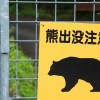 Bear attacks car in Japan, breaks windshield with its paw【Video】
Bear attacks car in Japan, breaks windshield with its paw【Video】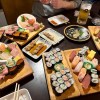 Shinjuku izakaya’s all-you-can-eat-and-drink plan is one of Tokyo’s best secret cheap eats
Shinjuku izakaya’s all-you-can-eat-and-drink plan is one of Tokyo’s best secret cheap eats Studio Ghibli unveils new goods that tip the hat to The Cat Returns
Studio Ghibli unveils new goods that tip the hat to The Cat Returns Foreigner’s request for help in Tokyo makes us sad for the state of society
Foreigner’s request for help in Tokyo makes us sad for the state of society Bad tourist manners at Mt Fuji Lawson photo spot prompts Japanese town to block view with screens
Bad tourist manners at Mt Fuji Lawson photo spot prompts Japanese town to block view with screens Japanese city loses residents’ personal data, which was on paper being transported on a windy day
Japanese city loses residents’ personal data, which was on paper being transported on a windy day Two things to do, and two things not to do, when leaving a traditional Japanese inn
Two things to do, and two things not to do, when leaving a traditional Japanese inn Ghibli Park now selling “Grilled Frogs” from food cart in Valley of Witches
Ghibli Park now selling “Grilled Frogs” from food cart in Valley of Witches Red light district sushi restaurant in Tokyo shows us just how wrong we were about it
Red light district sushi restaurant in Tokyo shows us just how wrong we were about it Studio Ghibli unveils massive T-shirt collection featuring top anime movie characters
Studio Ghibli unveils massive T-shirt collection featuring top anime movie characters McDonald’s new Happy Meals offer up cute and practical Sanrio lifestyle goods
McDonald’s new Happy Meals offer up cute and practical Sanrio lifestyle goods New definition of “Japanese whiskey” goes into effect to prevent fakes from fooling overseas buyers
New definition of “Japanese whiskey” goes into effect to prevent fakes from fooling overseas buyers Our Japanese reporter visits Costco in the U.S., finds super American and very Japanese things
Our Japanese reporter visits Costco in the U.S., finds super American and very Japanese things Japanese ramen restaurants under pressure from new yen banknotes
Japanese ramen restaurants under pressure from new yen banknotes All-you-can-drink Starbucks and amazing views part of Tokyo’s new 170 meter-high sky lounge
All-you-can-drink Starbucks and amazing views part of Tokyo’s new 170 meter-high sky lounge More foreign tourists than ever before in history visited Japan last month
More foreign tourists than ever before in history visited Japan last month New Pokémon cakes let you eat your way through Pikachu and all the Eevee evolutions
New Pokémon cakes let you eat your way through Pikachu and all the Eevee evolutions Disney princesses get official manga makeovers for Manga Princess Cafe opening in Tokyo
Disney princesses get official manga makeovers for Manga Princess Cafe opening in Tokyo Sales of Japan’s most convenient train ticket/shopping payment cards suspended indefinitely
Sales of Japan’s most convenient train ticket/shopping payment cards suspended indefinitely Sold-out Studio Ghibli desktop humidifiers are back so Totoro can help you through the dry season
Sold-out Studio Ghibli desktop humidifiers are back so Totoro can help you through the dry season Japanese government to make first change to romanization spelling rules since the 1950s
Japanese government to make first change to romanization spelling rules since the 1950s Ghibli founders Toshio Suzuki and Hayao Miyazaki contribute to Japanese whisky Totoro label design
Ghibli founders Toshio Suzuki and Hayao Miyazaki contribute to Japanese whisky Totoro label design Doraemon found buried at sea as scene from 1993 anime becomes real life【Photos】
Doraemon found buried at sea as scene from 1993 anime becomes real life【Photos】 Tokyo’s most famous Starbucks is closed
Tokyo’s most famous Starbucks is closed One Piece characters’ nationalities revealed, but fans have mixed opinions
One Piece characters’ nationalities revealed, but fans have mixed opinions We asked a Uniqlo employee what four things we should buy and their suggestions didn’t disappoint
We asked a Uniqlo employee what four things we should buy and their suggestions didn’t disappoint Video of each Japanese hiragana getting “measured up” is oddly cute and satisfying【Video】
Video of each Japanese hiragana getting “measured up” is oddly cute and satisfying【Video】 Japanese adult acts as perfect train driver using just a children’s picture book 【Video】
Japanese adult acts as perfect train driver using just a children’s picture book 【Video】 Japanese elementary school student teaches us all how to pronounce English like a native speaker
Japanese elementary school student teaches us all how to pronounce English like a native speaker Singing and dancing lessons, too!? An inside-look at a Tokyo voice acting academy
Singing and dancing lessons, too!? An inside-look at a Tokyo voice acting academy Japanese “nose-gargling” advertisement attracts attention on Tokyo’s trains
Japanese “nose-gargling” advertisement attracts attention on Tokyo’s trains Revolutionary A.I. voice software produces incredible vocals that sound just like a real human
Revolutionary A.I. voice software produces incredible vocals that sound just like a real human “The revolutionary way to pick your nose!” We try out the Nose Picker
“The revolutionary way to pick your nose!” We try out the Nose Picker Japanese-language voice for League of Legends’ Wukong revealed, sounds kinda familiar…
Japanese-language voice for League of Legends’ Wukong revealed, sounds kinda familiar… Japanese anime girl virtual YouTuber also speaks perfect English!【Video】
Japanese anime girl virtual YouTuber also speaks perfect English!【Video】 There’ll be hell toupee after devil winds cause hair-raising mayhem across Japan
There’ll be hell toupee after devil winds cause hair-raising mayhem across Japan Japanese writing system gets turned into handsome anime men with Hiragana Boys video game
Japanese writing system gets turned into handsome anime men with Hiragana Boys video game Everyday Japanese names that make English speakers chuckle
Everyday Japanese names that make English speakers chuckle Here’s what happens when Cowboy Bebop’s star voice actor tries imitating a bird【Video】
Here’s what happens when Cowboy Bebop’s star voice actor tries imitating a bird【Video】 Otaku crowd control could be changing with new “anime character voice” megaphones
Otaku crowd control could be changing with new “anime character voice” megaphones Voice of beloved Japanese kid’s show character speaks out about living with ALS
Voice of beloved Japanese kid’s show character speaks out about living with ALS Muji’s garlic sauce potato chips are perfectly pungent enough to warrant an investigation
Muji’s garlic sauce potato chips are perfectly pungent enough to warrant an investigation
Leave a Reply